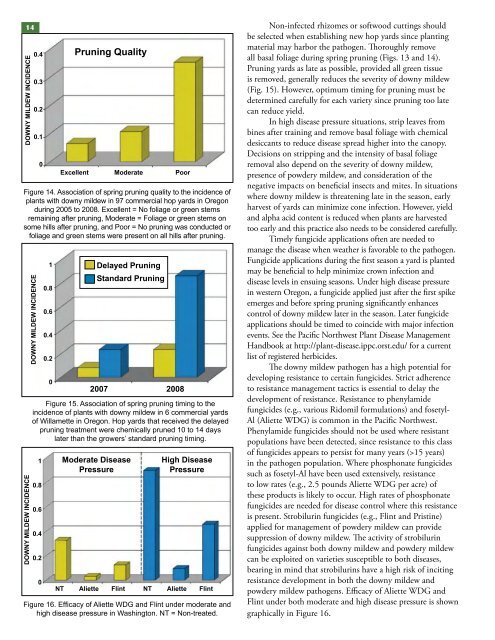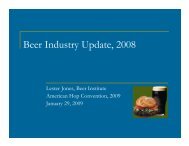Field Guide for Integrated Pest Management in Hops
Field Guide for Integrated Pest Management in Hops
Field Guide for Integrated Pest Management in Hops
You also want an ePaper? Increase the reach of your titles
YUMPU automatically turns print PDFs into web optimized ePapers that Google loves.
14DOWNY MILDEW INCIDENCEFigure 14. Association of spr<strong>in</strong>g prun<strong>in</strong>g quality to the <strong>in</strong>cidence ofplants with downy mildew <strong>in</strong> 97 commercial hop yards <strong>in</strong> Oregondur<strong>in</strong>g 2005 to 2008. Excellent = No foliage or green stemsrema<strong>in</strong><strong>in</strong>g after prun<strong>in</strong>g, Moderate = Foliage or green stems onsome hills after prun<strong>in</strong>g, and Poor = No prun<strong>in</strong>g was conducted orfoliage and green stems were present on all hills after prun<strong>in</strong>g.DOWNY MILDEW INCIDENCEDOWNY MILDEW INCIDENCE0.40.30.20.10Figure 15. Association of spr<strong>in</strong>g prun<strong>in</strong>g tim<strong>in</strong>g to the<strong>in</strong>cidence of plants with downy mildew <strong>in</strong> 6 commercial yardsof Willamette <strong>in</strong> Oregon. Hop yards that received the delayedprun<strong>in</strong>g treatment were chemically pruned 10 to 14 dayslater than the growers’ standard prun<strong>in</strong>g tim<strong>in</strong>g.10.80.60.40.2010.80.60.40.20NTPrun<strong>in</strong>g QualityExcellent Moderate PoorDelayed Prun<strong>in</strong>gStandard Prun<strong>in</strong>g2007 2008Moderate DiseasePressureHigh DiseasePressureAliette Fl<strong>in</strong>t NT Aliette Fl<strong>in</strong>tFigure 16. Efficacy of Aliette WDG and Fl<strong>in</strong>t under moderate andhigh disease pressure <strong>in</strong> Wash<strong>in</strong>gton. NT = Non-treated.Non-<strong>in</strong>fected rhizomes or softwood cutt<strong>in</strong>gs shouldbe selected when establish<strong>in</strong>g new hop yards s<strong>in</strong>ce plant<strong>in</strong>gmaterial may harbor the pathogen. Thoroughly removeall basal foliage dur<strong>in</strong>g spr<strong>in</strong>g prun<strong>in</strong>g (Figs. 13 and 14).Prun<strong>in</strong>g yards as late as possible, provided all green tissueis removed, generally reduces the severity of downy mildew(Fig. 15). However, optimum tim<strong>in</strong>g <strong>for</strong> prun<strong>in</strong>g must bedeterm<strong>in</strong>ed carefully <strong>for</strong> each variety s<strong>in</strong>ce prun<strong>in</strong>g too latecan reduce yield.In high disease pressure situations, strip leaves fromb<strong>in</strong>es after tra<strong>in</strong><strong>in</strong>g and remove basal foliage with chemicaldesiccants to reduce disease spread higher <strong>in</strong>to the canopy.Decisions on stripp<strong>in</strong>g and the <strong>in</strong>tensity of basal foliageremoval also depend on the severity of downy mildew,presence of powdery mildew, and consideration of thenegative impacts on beneficial <strong>in</strong>sects and mites. In situationswhere downy mildew is threaten<strong>in</strong>g late <strong>in</strong> the season, earlyharvest of yards can m<strong>in</strong>imize cone <strong>in</strong>fection. However, yieldand alpha acid content is reduced when plants are harvestedtoo early and this practice also needs to be considered carefully.Timely fungicide applications often are needed tomanage the disease when weather is favorable to the pathogen.Fungicide applications dur<strong>in</strong>g the first season a yard is plantedmay be beneficial to help m<strong>in</strong>imize crown <strong>in</strong>fection anddisease levels <strong>in</strong> ensu<strong>in</strong>g seasons. Under high disease pressure<strong>in</strong> western Oregon, a fungicide applied just after the first spikeemerges and be<strong>for</strong>e spr<strong>in</strong>g prun<strong>in</strong>g significantly enhancescontrol of downy mildew later <strong>in</strong> the season. Later fungicideapplications should be timed to co<strong>in</strong>cide with major <strong>in</strong>fectionevents. See the Pacific Northwest Plant Disease <strong>Management</strong>Handbook at http://plant-disease.ippc.orst.edu/ <strong>for</strong> a currentlist of registered herbicides.The downy mildew pathogen has a high potential <strong>for</strong>develop<strong>in</strong>g resistance to certa<strong>in</strong> fungicides. Strict adherenceto resistance management tactics is essential to delay thedevelopment of resistance. Resistance to phenylamidefungicides (e.g., various Ridomil <strong>for</strong>mulations) and fosetyl-Al (Aliette WDG) is common <strong>in</strong> the Pacific Northwest.Phenylamide fungicides should not be used where resistantpopulations have been detected, s<strong>in</strong>ce resistance to this classof fungicides appears to persist <strong>for</strong> many years (>15 years)<strong>in</strong> the pathogen population. Where phosphonate fungicidessuch as fosetyl-Al have been used extensively, resistanceto low rates (e.g., 2.5 pounds Aliette WDG per acre) ofthese products is likely to occur. High rates of phosphonatefungicides are needed <strong>for</strong> disease control where this resistanceis present. Strobilur<strong>in</strong> fungicides (e.g., Fl<strong>in</strong>t and Prist<strong>in</strong>e)applied <strong>for</strong> management of powdery mildew can providesuppression of downy mildew. The activity of strobilur<strong>in</strong>fungicides aga<strong>in</strong>st both downy mildew and powdery mildewcan be exploited on varieties susceptible to both diseases,bear<strong>in</strong>g <strong>in</strong> m<strong>in</strong>d that strobilur<strong>in</strong>s have a high risk of <strong>in</strong>cit<strong>in</strong>gresistance development <strong>in</strong> both the downy mildew andpowdery mildew pathogens. Efficacy of Aliette WDG andFl<strong>in</strong>t under both moderate and high disease pressure is showngraphically <strong>in</strong> Figure 16.








